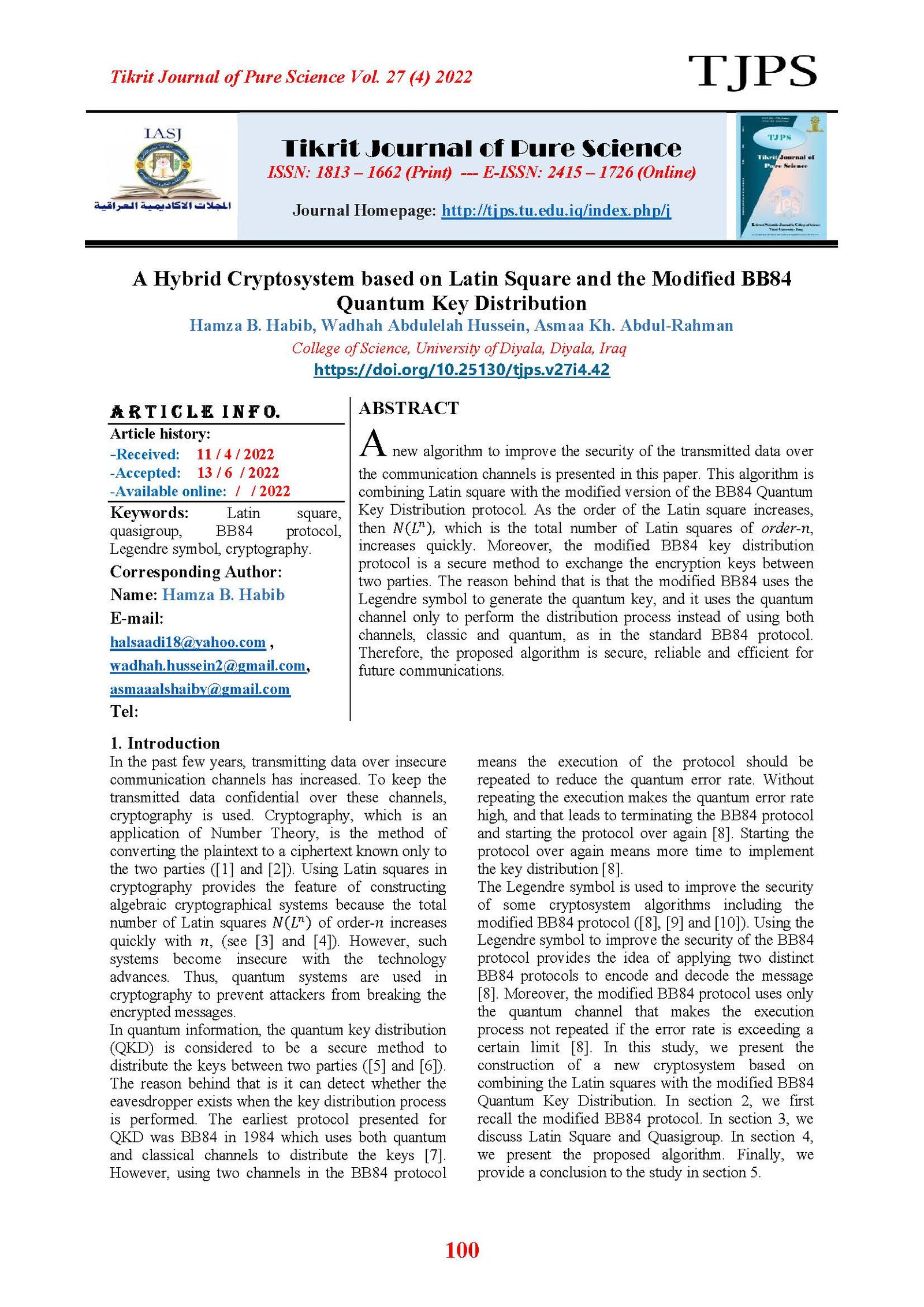A Hybrid Cryptosystem based on Latin Square and the Modified BB84 Quantum Key Distribution
Main Article Content
Abstract
A new algorithm to improve the security of the transmitted data over the communication channels is presented in this paper. This algorithm is combining Latin square with the modified version of the BB84 Quantum Key Distribution protocol. As the order of the Latin square increases, then , which is the total number of Latin squares of order- , increases quickly. Moreover, the modified BB84 key distribution protocol is a secure method to exchange the encryption keys between two parties. The reason behind that is that the modified BB84 uses the Legendre symbol to generate the quantum key, and it uses the quantum channel only to perform the distribution process instead of using both channels, classic and quantum, as in the standard BB84 protocol. Therefore, the proposed algorithm is secure, reliable and efficient for future communications
Article Details

This work is licensed under a Creative Commons Attribution 4.0 International License.
Tikrit Journal of Pure Science is licensed under the Creative Commons Attribution 4.0 International License, which allows users to copy, create extracts, abstracts, and new works from the article, alter and revise the article, and make commercial use of the article (including reuse and/or resale of the article by commercial entities), provided the user gives appropriate credit (with a link to the formal publication through the relevant DOI), provides a link to the license, indicates if changes were made, and the licensor is not represented as endorsing the use made of the work. The authors hold the copyright for their published work on the Tikrit J. Pure Sci. website, while Tikrit J. Pure Sci. is responsible for appreciate citation of their work, which is released under CC-BY-4.0, enabling the unrestricted use, distribution, and reproduction of an article in any medium, provided that the original work is properly cited.
References
[1] Barakat, M., Eder, C. and Hanke, T., 2018. “An introduction to cryptography”. Timo Hanke at RWTH Aachen University, pp.1-145.
[2] Easttom, W., 2021. “Essential Number Theory and Discrete Math”. In Modern Cryptography (pp. 73-104). Springer, Cham.
[3] Pal, S. K., Kapoor, S., Arora, A., Chaudhary, R. & Khurana, J., “Design of strong cryptographic schemes based on Latin Squares”, Journal of Discrete Mathematical Sciences and Cryptography, vol. 13, no. 3, pp. 233–256, 2010, doi: 10.1080/09720529.2010.10698290
[4] McKay, B.D. and Wanless, I.M., 2022. “Enumeration of Latin squares with conjugate symmetry”. Journal of Combinatorial Designs, 30(2), pp.105-130.
[5] Charles H. Bennett, Gilles Brassard, “Quantum cryptography: Public key distribution and coin tossing”. Theoretical Computer Science, Volume 560, Part 1, 2014, Pages 7-11, https://doi.org/10.1016/j.tcs.2014.05.025.
[6] Bunandar, D., Govia, L.C.G., Krovi, H. et al. “Numerical finite-key analysis of quantum key distribution”. npj Quantum Inf 6, 104, 2020. https://doi.org/10.1038/s41534-020-00322-w
[7] Abdullah, Alharith A., Rifaat Z. Khalaf, & Hamza B. Habib. “Modified BB84 Quantum Key
Distribution Protocol Using Legendre Symbol”. 2nd Scientific Conference of Computer Sciences (SCCS), University of Technology – Iraq, IEEE, 2019.
[8] Habib, H. B. “Modifying Playfair Cipher Algorithm by using Legendre Symbol”. Diyala Journal for Pure Science (DJPS), vol. 15, no. 4, pp. 74-84, 2019. DOI: https://dx.doi.org/10.24237/djps.15.04.502A
[9] Habib, H. B., Wadhah Abdulelah Hussein, & Diana Saleh Mahdi. “Improving the security of the Knapsack Cryptosystem by using Legendre Symbol”. Turkish Journal of Computer and Mathematics Education, vol. 12, no. 11, pp. 2249-2255, 2021.
[10] Schmidt, N. O. “Latin Squares and Their Applications to Cryptography”. Boise State University. 016.
[11] Grošek, Otokar and Sýs, Marek. “Isotopy of latin squares in cryptography”. Tatra Mountains Mathematical Publications, vol.45, no.1, pp.27-36, 2012 https://doi.org/10.2478/v10127-010-0003-z
[12] Prasad, V.B.V.N., & J.Venkateswara Rao. “Characterization of Quasigroups and Loops”. International Journal of Scientific and Innovative Mathematical Research (IJSIMR), vol. 1, no. 2, pp. 95-102, 2013.
